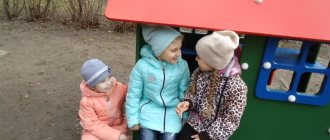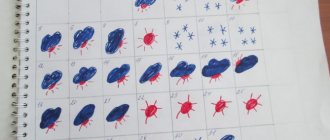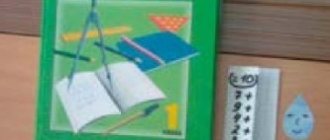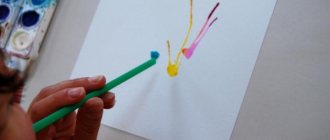Number houses
Houses with numbers are the next step in learning the composition of numbers. They are a building with a roof and two apartments on each floor. There is always a number on the roof that splits into two others that live next door to each other. The number of floors depends on the number of possible combinations: the higher the number, the more options for laying it out and the higher the house.
To understand the composition of a number with your child, just draw such a house. For example, for the number 3 it will have 2 floors, on which 0 with 3 and 1 with 2 are adjacent
Having explained the main principle, you need to give children the opportunity to fill out the number houses on their own: leave them empty and indicate only the number on the roof, the composition of which must be distributed among the floors. You can start from the bottom floor or from the top.
If the task is difficult, you can fill in some of the boxes as a hint. But in the future it should be explained that each number, moving from one floor to another, becomes 1 more or less. And if in one apartment there is a decrease of 1, then in the next one there will be an increase of 1.
After the compositions of numbers up to 10 have been mastered, you can move on to the second ten, if the child is familiar with it.
Preparatory group. Senior preschool age. Children 6-7 years old
Notes on FEMP using the author's manual "Voskobovich's Games" with children of the preparatory group "Composition of the number 10" Notes on FEMP using the author's manual " Voskobovich's Games "
with children of the preparatory group.
Full name of teacher: Chernyshova O.V. Preschool educational institution: MBDOU "Khomutovsky kindergarten"
Program objectives: 1. Introduce the
composition of the number 10 from units . 2. Continue learning to find the previous number ...
Summary of the game situation for FEMP “Recognize the hero of the fairy tale. Composition of the number 10 from units" (preparatory group) Municipal budgetary preschool educational institution "Kindergarten No. 137"
Summary of a game situation on the formation of elementary mathematical concepts in children Topic:
“Get to know the hero of a fairy tale”
preparatory group Nizhny Novgorod region, Dzerzhinsk 2021...
Activities with number cards
Number cards are pictures where the number of objects corresponds to a certain number.
It is with these cards that it is best to start getting acquainted with the composition of numbers, because this method is visual and more accessible. Here is an example of such cards:
First, you should explain to your child what addition is: adding another to one number, we get a third number. This is best demonstrated on small objects (candies, buttons, pebbles, pencils, etc.) or cards: for example, on one there are 2 bananas, and on the other 3 oranges. If you add them together, how many fruits do you get? The child counts all the fruits and names the amount. At the same time, he gradually remembers how much it will be if you add up certain numbers.
Once you have an understanding of the process of adding different objects, you can take on the composition of a number. The adult names the number of items that should be obtained in the end, and together with the child they collect different combinations. It is better to start with small numbers and gradually increase.
For example, you need to collect 4 apples. We offer the child a card with only 1 apple drawn and ask which one else needs to be chosen so that there are 4 apples in the end. Then we take a card with a picture of 2 apples and ask the same question. Thus, all possible combinations are tried.
Gradually you can move on to larger numbers, where the number of combinations will increase. With repeated repetition, the composition of each number is stored in memory and then reproduced mechanically.
When to start studying the composition of numbers
The most suitable age for immersing yourself in the topic of number composition is 6 years old, the time of preparation for school. But in some cases, it is appropriate to start studying the composition of small numbers earlier. It all depends on the individual characteristics of the child and the base that he already owns, namely:
- mental counting skill (in other words, you need to be able to assign a serial number to any objects);
- mental counting skill in reverse order;
- knowledge of the graphic image of numbers (remember how they look visually and are easy to recognize);
- An advantage is the ability to write down the number yourself.
You should move on to mastering the composition of numbers after consolidating the above skills in order to avoid difficulties and misunderstandings. This means you need to start by learning the numbers from 1 to 10.
MAGAZINE Preschooler.RF
Lesson summary for the preparatory group “Composition of the number 5”Goal: to introduce children to the composition of the number five from two smaller numbers.
Tasks:
- introduce the composition of the number 5, that it consists of two smaller numbers
- strengthen the ability to name the number “one more”
- develop attention and memory, logical thinking.
Materials and equipment: multimedia presentation, three hoops, balls for each child with circles depicted on them, a large ball, a math set for each child.
Progress of the lesson:
Educator: Hello guys, please listen to the poem.
Let's guys learn to count! Remember everything that without an accurate count, no work will move forward. Without an account there will be no light on the street,
Without counting, the rocket won't be able to rise, And the kids won't be able to play hide and seek. Get to work guys quickly, learn to count so as not to lose count.
Tell me, what are we going to do today?
Children: Let's count.
Educator: That's right. But first I suggest you play. I will throw the ball and call the number, throwing the ball back to me, you will call the number one more. Three... (four), five... (six), eight... (nine), etc.
Game “Throw the ball and call the number”
Educator: Well done guys. Now let's go to the tables.
In front of each child there is a set of geometric shapes on the table.
Educator: Please look at the board (red squares appear on the screen one by one). Let's do the math with you.
The teacher and the children count squares 1, 2, 3, 4, 5.
Educator: Okay. Place 5 red squares in front of you.
Children lay out squares in front of them.
Educator: Now let's replace the last square with a yellow square. (Children change squares on the interactive board as desired) How many red squares are there in a row?
Children: Four.
Educator: How many yellow squares?
Children: One.
Educator: How many squares are there in total?
Children: There are five squares in total.
Educator: That's right. Four and one, and a total of five. Now count out three red squares and place them under the squares of the first row.
At this time, a number of squares are also displayed on the screen.
Educator: Now count out two yellow squares and place them next to the red ones. How many red squares?
Children: Three.
Educator: How many yellow squares?
Children: Two.
Educator: How many squares are there in total?
Children: There are five squares in total.
Educator: That means three and two, and a total of five. Now count out two red squares and place them under the squares of the second row. Fine. And three squares of yellow color and put them next to the red ones. How many red squares?
Children: Two.
Educator: How many squares are yellow?
Children: Three.
Educator: That means two and three, and a total of five. Now count out one red square and place it under the squares of the third row. Fine. And four squares of yellow color and put them next to the red one. How many red squares?
Children: One.
Educator: How many yellow squares?
Children: Four.
Educator: Correct. One and four, and a total of five. Now let's repeat all the options for the composition of the number 5.
Children: Four and one, three and two, two and three, one and four.
Educator: Absolutely right. Now I suggest you play a little.
Outdoor activity “Playing with apples”
There are hoops on the floor, at a distance from each other, with numbers in them (3, 4, 5). There are apples in the basket with circles (3, 4, 5) glued on them. At the teacher’s command, the children take any apple and start running to the music. As soon as the music stops playing, the children find the hoop with the desired number and stand near it. The game is repeated 2 - 3 times.
Educator: Well done guys. Oh, what is this on our screen?
Children: House.
A house with the number 5 appears on the screen.
Educator: Guys, let's remember what smaller numbers the number five consists of.
Children take turns calling to the multimedia board and clicking on empty windows located on the floors of the house.
Educator: You guys all did well today. What did we learn about today?
Children: About the fact that the number five consists of two numbers: 4 and 1, 2 and 3, 3 and 2, 1 and 4. Educator: Well done guys.
| Next > |





